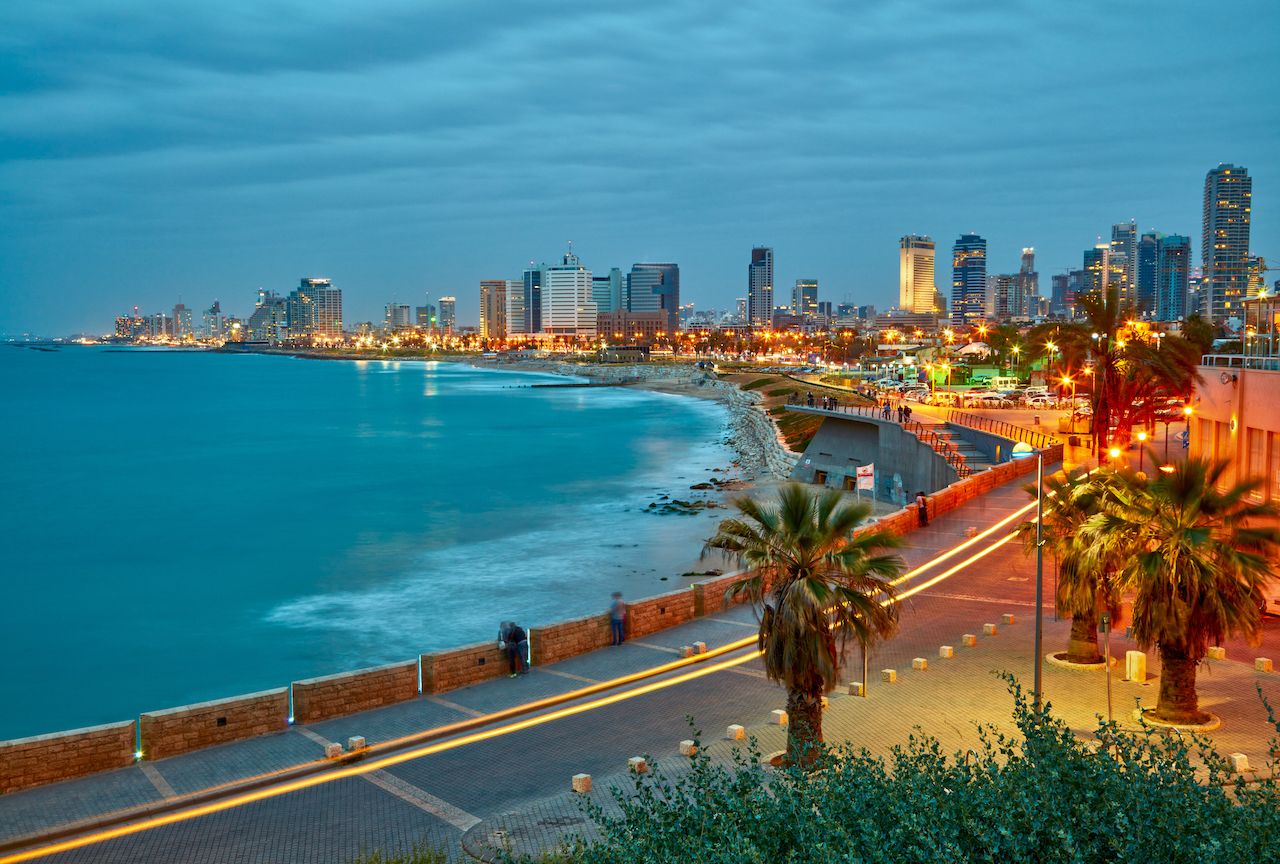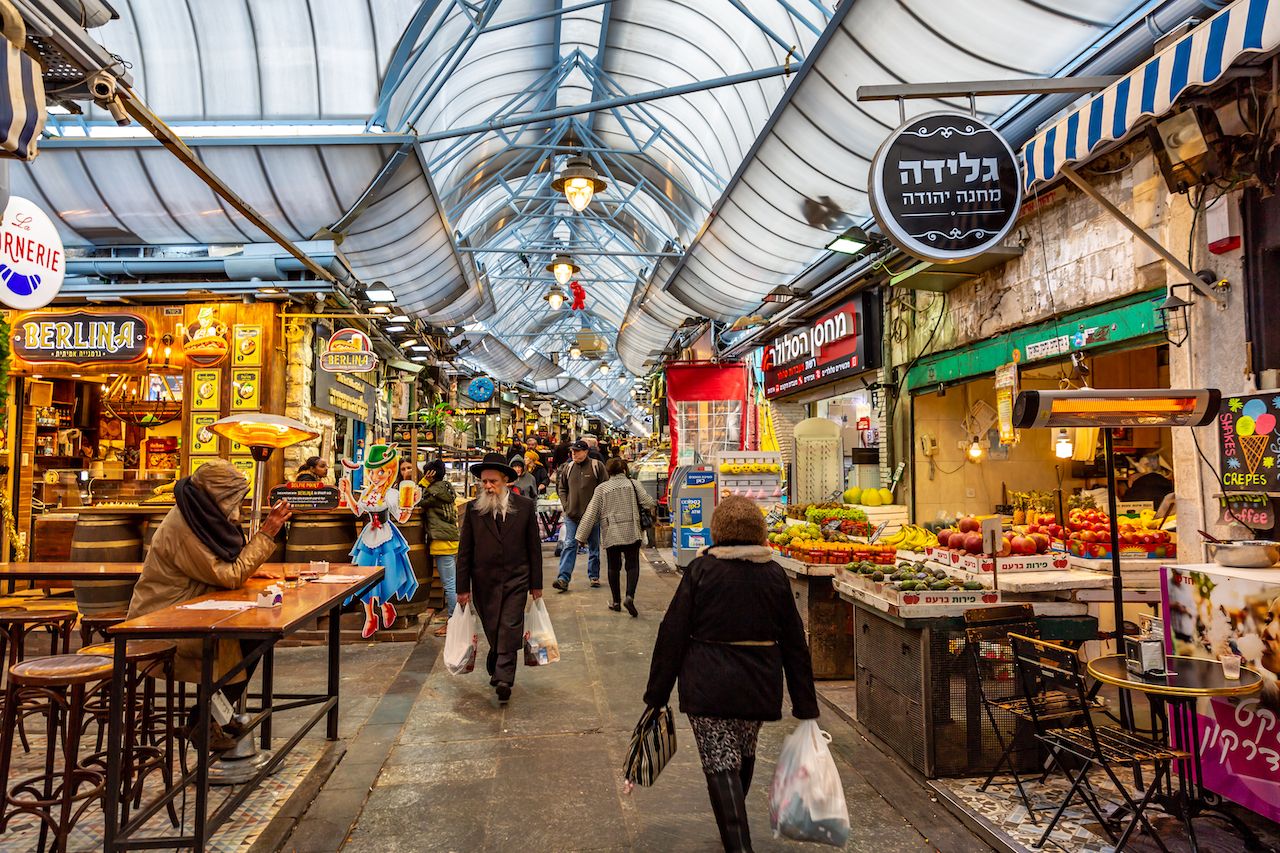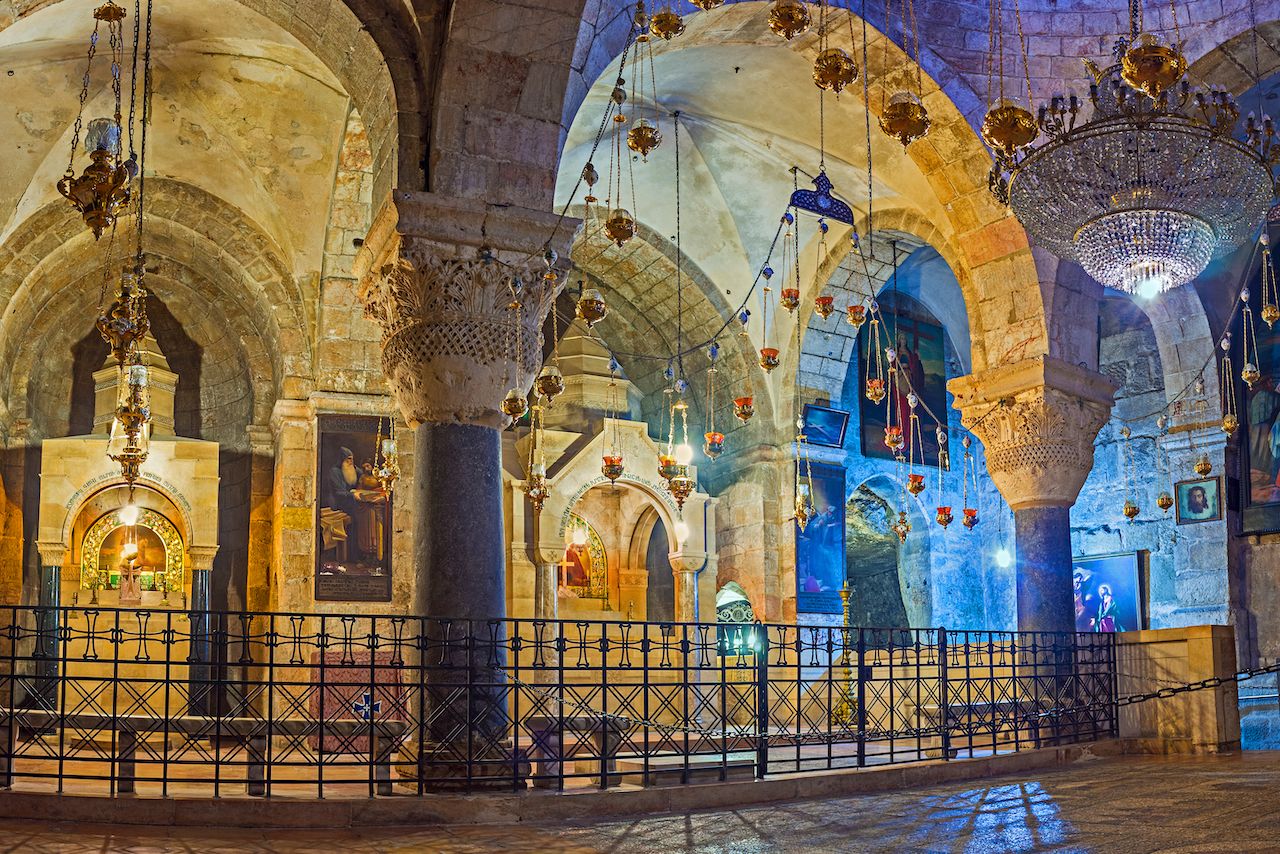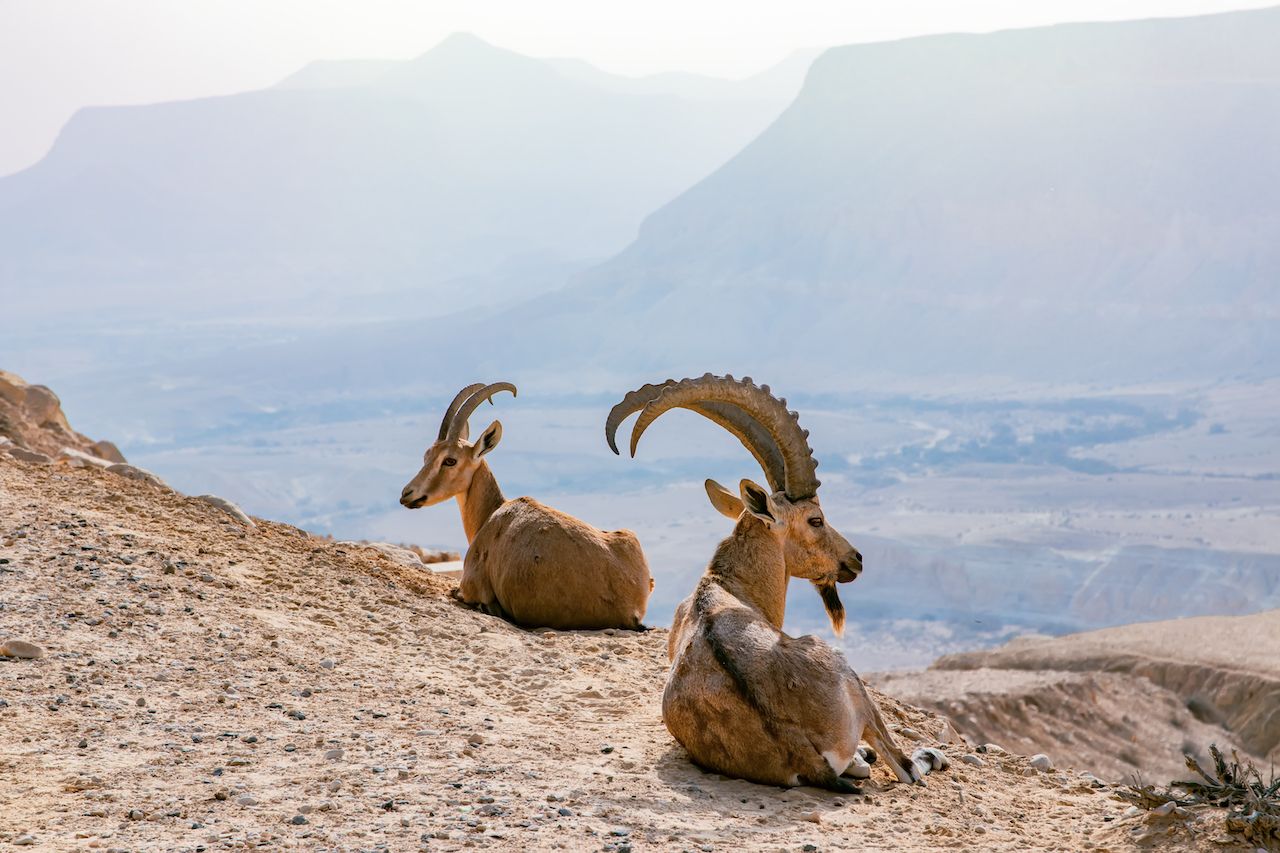From the sun-kissed, seaside hedonism of Tel Aviv to the ancient walls and alleyways of Jerusalem and Jaffa, Israel’s cities are among the world’s most historically rich and culturally compelling. Add in a soothing float on the Dead Sea, an oasis encounter with wild ibexes, and the spectacular views atop the ancient fortress of Masada, and your trip to Israel can be a breathtaking adventure. And no matter how you decide to spend your time in this Middle Eastern country, you’ll be fueled by some of the most delicious food in the world. If it’s once-in-a-lifetime experiences you crave, Israel is one of the most fascinating destinations you can visit this year. Here’s how to make the most of a trip.

From Markets to the Masada, These Are the Most Exciting Experiences in Israel
1. Get to know Tel Aviv

Photo: The World in HDR/Shutterstock
This Mediterranean metropolis does revelry right. Think of it as a slice of Southern California in the Middle East. Most days, you’ll find sun-worshippers playing volleyball, lounging around, or surfing at any of the numerous white-powder beaches that stretch along the city’s nine-mile coast. When it comes to the world’s best beach destinations, Tel Aviv is often overlooked — but it shouldn’t be. For surf, sun, and great beachside hotels, Israel’s biggest city delivers.
Venture inland to Tel Aviv’s tree-lined Rothschild Boulevard, and you’ll find yourself in a stroller-and-shopper’s dream. If long walks aren’t your thing, hop onto one of the hundreds of electric scooters that tourists and locals alike use in abundance. They’re cheap, easy to operate, and for some in Tel Aviv, the height of nuisance. But in a country that largely shuts down on Saturdays (though much less so in Tel Aviv), or if you’re in a time crunch, these scooters can be a savior.
Whatever mode of exploration you choose, be sure to enjoy at least one of Rothschild’s many coffee kiosks and cruise past the hundreds of restored Bauhaus-era buildings in the surrounding White City. When hunger kicks in, Bino B’Pita offers chef-worthy, easy-to-grub pitas, or stop by the ultra-hip Cafe Europa for top-quality Israeli food and drink.
2. Walk through the port of Jaffa

Photo: Aline Fortuna/Shutterstock
South of Tel Aviv is the 4,000-year-old port city of Jaffa. It’s home to 30,000 Jews and 16,000 Arabs and is regarded as an example of ethnic inclusivity. One of the highlights here, as in any Israeli city, is its flourishing outdoor market. Known as Shuk HaPishpeshim, the Jaffa Flea Market is brimming with restaurants, boutique shops, and galleries, along with Turkish bazaar-like laneways selling everything from clothing, fabric, and antique jewelry to trinkets, musical instruments, and much more.
After all the perusing, haggling, and shopping, you’ll need to relax at one of the many renowned restaurants of the Jaffa Flea Market. Among the most unique — and distinctively Israeli — is the well-loved Cafe Puaa on Rabbi Yohanan Street. This vintage-furnished spot serves homestyle Israeli fare in a cozy but vibrant atmosphere.
If it’s all-day breakfast you’re after, Dr. Shakshuka is your remedy. People flock here for the Israeli morning staple shakshuka, which consists of baked eggs in tomato sauce in various renditions.
In Kedumim Square in Old Jaffa, a short walk from the Flea Market, is Abrage Restaurant. Here you can choose from an extensive selection of traditional Mediterranean dishes and seafood specialties while a light sea breeze blows through the 100-year-old historic building.
3. Out on the town in Tel Aviv

Photo: SJ Travel Photo and Video/Shutterstock
Tel Aviv’s nightlife is nonstop, so when the sun goes down, things really heat up. With dozens of clubs, bars, and after-hours hangouts to choose from, here are some of the trendier gathering spots.
Say the words “Kuli Alma” and locals will give you a knowing wink. This multi-level venue will assault your senses in the best way. A labyrinth of rooms will have you dancing shoulder to shoulder to different musical styles while surrounded by charming, spirited décor. If you’re a vintage rock lover, take a few minutes during the night to head to the small room selling stylish vintage clothes.
Across from Tel Aviv’s largest synagogue is the restaurant, bar, and record library hybrid known as Port Said. It’s as cool as Tel Aviv gets. Expect to see the patio packed with dozens of attractive Millennials and Gen Z-ers. The atmosphere is hip, laid-back and the music tastefully retro. Pick a record from the massive wall of vinyl, and the DJ will be happy to spin it.
Down an alley off of Allenby Street, red pathway lights will lead you to another of Tel Aviv’s favorite venues, the retro-futuristic Sputnik. If you’ve ever been to a Budapest ruin bar then you’ll appreciate the exposed brick walls hung with eclectic art and the multiple rooms blasting different genres of music. Find a cozy corner or join the throng getting wild on the dance floor.
4. Jerusalem’s Mahane Yehuda Market embodies the vibe of the city

Photo: Subodh Agnihotri/Shutterstock
When you need a break from the world-class partying, head to Jerusalem. Israel’s capital is more than willing to absolve you of any sins incurred in Tel Aviv. It contains sites holy to Christianity, Islam, and Judaism, hence its moniker as The Holy City.
A good place to ease into Jerusalem is the Mahane Yehuda Market. Its open-air portion is perfect for those in search of produce and meat, while the covered portion contains a line of stalls selling pastries, spices, nuts, ice cream and much more. Be sure to try a quintessential Palestinian treat called a Kanafeh, a pastry made from cheese, almonds, pistachios, orange food coloring, and tons of sugar. Come back at night and the same market will have transformed into a hub of restaurants and bars.
5. You don’t have to be religious to enjoy Jerusalem

Photo: eFesenko/Shutterstock
A walk in the Old City will take you through Jerusalem’s four quarters: Muslim, Christian, Jewish, and Armenian. On most days, the narrow alleyways buzz with activity as hundreds of pilgrims from across the globe come to worship at the Western Wall, Dome of the Rock, St. James Church, al-Aqsa Mosque, or Church of the Holy Sepulchre. The energy of the Old City will be palpable, the religious significance of these sites being sacred to so many.
From any vantage point in Jerusalem, you’ll likely see the gold-plated Dome of the Rock. It stands as the symbol of the city and is one of the most-photographed buildings on the planet. The impressive dome covers a stone slab that’s sacred to both the Muslim and Jewish faiths. Only Muslims can enter the temple, but anyone can see it from the outside while walking around the plaza. Either way, dress modestly.
At the edge of the Christian and Muslim quarters is The Church of the Holy Sepulchre, one of Christianity’s most sacred sites. Pilgrims have been flocking here since the fourth century, many believing the church to be built over Calvary or Golgotha, where Jesus was said to be crucified.
Once inside the ancient church, you’ll be hit with an overwhelming scent of burning incense and a crush of passionate believers. Below the main chapel dome, a rotunda supposedly contains Jesus’s tomb. Head back to the entrance, and you’re sure to witness dozens of worshippers lining up to kiss, touch, and rub a slab on the floor known as the Stone of Anointing. It’s here, according to Christian tradition, that the body of Jesus was prepared for burial following his crucifixion.
At the western edge of the Old City is the Wailing Wall, considered the holiest site for Jews. Make your way through the throng of worshippers and find a spot at the massive limestone wall. Once there you’ll notice that every available crack is stuffed with prayers written on folded bits of paper. There’s likely no more fitting a place than the Wailing Wall to place your hand and offer up positive thoughts to the world.
6. Isreali food, harvested from Jerusalem and Judea

Photo: Eucalyptus Restaurant – מסעדת האקליפטוס/Facebook
A visit to Jerusalem would not be complete without eating at Eucalyptus Restaurant. Located in the Artist Quarter, Eucalyptus is an unforgettable Jerusalem dining experience, serving reinvented biblical cuisine created by renowned Chef Moshe Basson. The robust, smiling, pony-tailed chef will no doubt visit your table to welcome you and have a chat. Chef Basson is passionate about food, and he’ll gladly tell you that many of the spices and herbs used in his dishes were wildcrafted in the surrounding hills of Judea and Jerusalem.
A feast at Eucalyptus might include slow-cooked neck of lamb with root vegetables stewed in a clay pot. The artichoke, tomato, and lentil soups, served side-by-side in shot glasses, are the ideal complement to the fish falafels, seared mallard breast, and slow-cooked neck of lamb that the restaurant is known for.
The idea of nightlife and Jerusalem don’t usually go hand in hand. But if you’ve had enough of visiting historical holy sites, then head to Ben Yehuda Street. For live music, from rock to funk to folk, then Yellow Submarine is the bar to check out.
More into good conversation and jazz? Step inside Gatsby, a 1920s-style speakeasy with expertly crafted cocktails, and sparkling ambiance.
Those more aligned with EDM should head over to Sira. Frequented by students, this tiny bar offers an equally tiny dance floor along with a great selection of beer and is a chance to meet locals who’ve gathered on its makeshift patio out front.
7. Desert adventures, from the Dead Sea to Ein Advat

Photo: vvvita/Shutterstock
At over 1,400 feet below sea level, the Dead Sea is part of the Great Rift Valley and is fed by the River Jordan. Its waters are shared by Israel, the Palestinian Territories, and Jordan.
Do you really float? This is a question most people are out to answer as they wade into the lake’s cobalt blue waters. With a salt concentration of 34% (10 times that of an ocean), the answer is a definitive yes. Try and actually swim a front stroke and your friends will have a good laugh at your expense. The best place for a dip is Ein Bokek Beach, along the southern end.
Pro tip: Do not get any of the water in your eyes. It stings like nothing else.

Photo: Orlov Sergei/Shutterstock
Rising above the Judean Desert on a plateau overlooking the Dead Sea is the rugged ancient fortress of Masada. For those in need of some exercise, hike the 1,312 feet up the famed Snake Path on the eastern flank of the mesa. Do it early enough and you’ll witness one of the most stunning sunrises this side of Haleakala.
For those with less time or athletic ability, a cable car is provided. Either way, at the top you’ll find the well-preserved ruins of King Herod’s 840-acre complex and breathtaking views of the Dead Sea and Jordan’s Moab Mountains beyond.
Legend has it that in 73 AD, after months of being under siege by Roman troops, nearly a thousand Jewish rebels at Masada took their own lives rather than live as Roman slaves.

Photo: Alexander Ingerman/Shutterstock
Eighty miles west of Masada is Ein Avdat, yet another of Israel’s strikingly beautiful sites. This national park is set within the Zin Valley in the center of Israel’s Negev Desert. The spectacular canyon stretches for over 30 miles and forms the longest wadi in the Negev.
A hike through the canyon will lead you along a spring flanked by poplar trees, palms, and tall grasses, with eroded walls rising high above on either side. Have your camera ready as you may be accompanied partway by curious ibexes.
At the bottom of Ein Avdat lies a deep pool fed by a 50-foot waterfall. Further along the hike and up a set of natural stairs, you’ll come to caves set high in the canyon walls. These dwellings date back to the Byzantine era and were carved out by Christian monks.
Ease into lotus position in one of these caves and let the ancient canyon breeze wash over you. A perfect end to an amazing trip through the Holy Land.